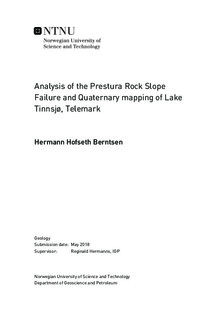| dc.description.abstract | This thesis covers an analysis of the Prestura rockslope failure and quaternary mapping of lake Tinnsjø. The analysis of the Prestura rockslope failure involves a structural analysis, kinematic analysis, volume calculations, empirical run-out analysis and semi-empirical displacement wave analysis.
Five different joint sets are identified close to the Prestura failure area by systematic field mapping, confirmed by structural analysis of terrestrial laser scan (TLS) data. The structural data achieved form field mapping were included in the kinematic analysis. The kinematic analysis shows that planar sliding, wedge sliding and direct toppling is feasible at steep slopes dipping over 60°. Thus, only considered as feasible failure modes for small rock volumes. Large scale rock slope failure was only considered feasible by a combination of the over 60° NE dipping exfoliation joint set (J1) and the less than 20° NE dipping foliation (SF), making the complex bi-planar sliding a feasible failure mode.
The volume of the potential failed rock masses is estimated to be 3 9 million m3. The volume of the displaced masses was estimated to be 2 3 million m3. The difference in volume suggest at least one pre-deglaciation event from the same source that deposited onto the glacier. The volume vs. run-out correlation of Prestura is considered similar to the Randa rockslide (Sartori et al., 2003) classifying the failure of the Prestura rockslope as a rockslide, where the failure lasted over several hours. The semi-empirical displacement wave analysis indicate that Prestura created displacement waves when it failed, however the rockslide is now considered dormant. Thus, this site does not present a high hazard at present.
The structural data and geomorphology of the Prestura rockslide has been compared to the Håkåneset rockslope, in order to understand why the Prestura rockslide failed catastrophically while the Håkåneset rockslope has deformed with low rates over a long time. The structural condition is identical at both slopes thus the steepness of the slope is the only difference that can be mapped out. While Prestura has an average slope inclination of 46° has Håkåneset an average slope inclination of 38°, hence Prestura has more slope sections with a dip where failure become kinematically feasible. This is supported by a general relief analysis showing that Tinnsjø is narrower and deeper at Prestura than at Håkåneset, suggesting stronger glacial slope oversteepening at that place.
Quaternary mapping, based on 2x2m resolution bathymetrical data, reveal landforms such as deltas with dunes, terraces interpreted as kame terraces, landslide scars, landslide deposits, and dead ice terrain at the lake floor. The most frequent mapped landform are landslide scars, with highest concentration along terraces close to the unstable slope of Håkåneset. This is considered as evidence of long-lasting movement of the Håkåneset rockslope. This is further supported by the presence of longitudinal ridges on the terrace surface. These are interpreted to be caused by the Håkåneset rockslide inducing into the terrace and bulldozing the sediments in front of the slide. Despite the high amount of landslide scars, no landslide deposits were mapped at the basin floor. This can be explained by the presence of high velocity currents at the bottom of lake Tinnsjø that can also trigger turbidity currents at the basin floor. Such turbidity currents are considered a potential hazard because they can break subaquatic cables. A larger risk to society might represent potential landslide triggered tsunamis from large subaquatic slope failures. When comparing the volumes of the largest subaquatic failures in lake Tinnsjø with other failures elsewhere in Norway such failures have caused considerable landslide- triggered tsunamis. However, in order to assess the hazard sediment characteristics that control the velocity of failure would have to be studied which is not part of this thesis. | |

